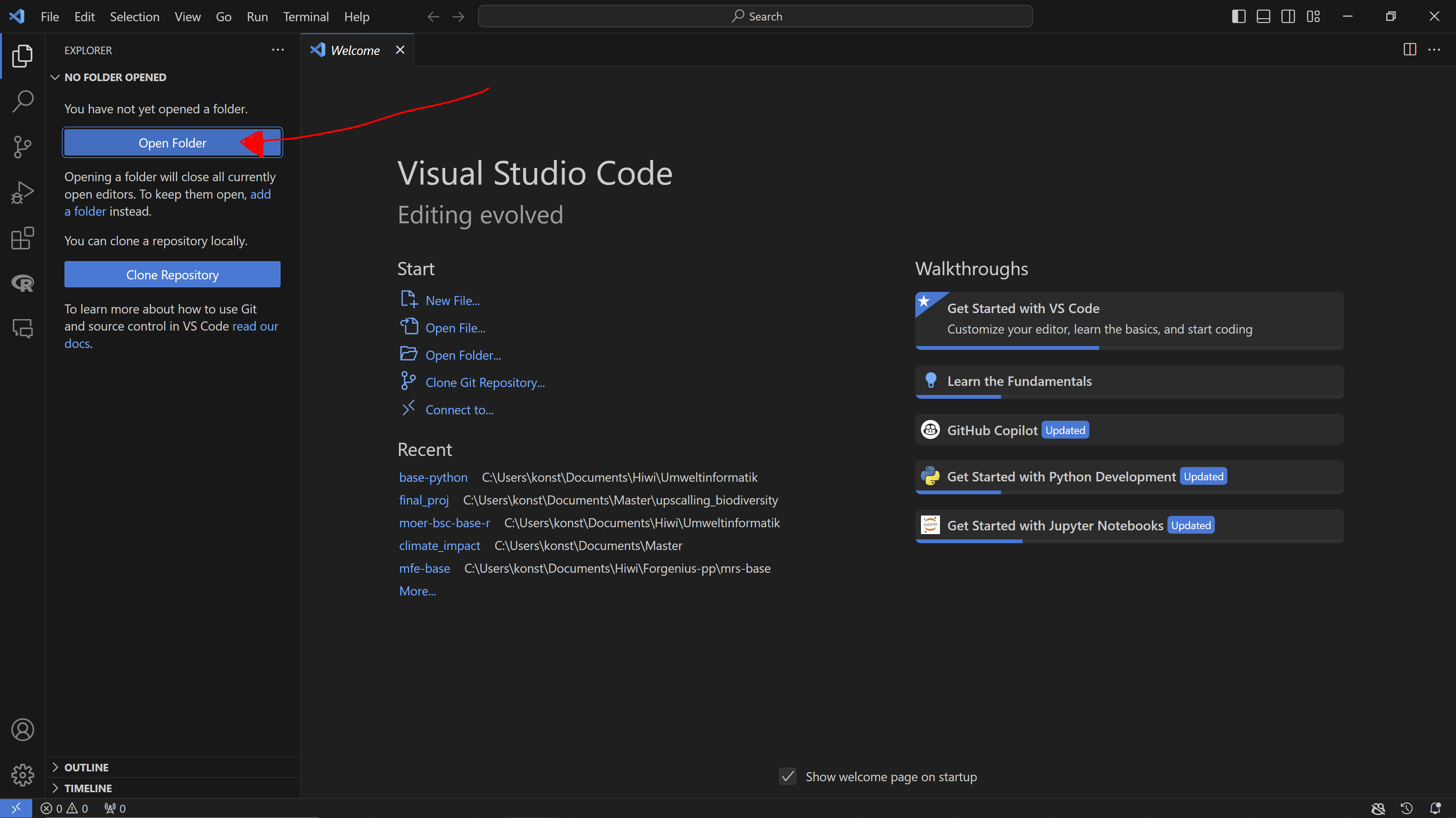Workspace
“Data is the new oil.” — Clive Humby
What is a workspace?**
“A workspace is (often) a file or directory that allows a user to gather various source code files and resources and work with them as a cohesive unit. Often these files and resources represent the complete state of an integrated development environment (IDE) at a given time, a snapshot. Workspaces are very helpful in cases of complex projects when maintenance can be challenging.” — Wikipedia
Let’s create a directory for this course if you don’t already have one. Create a folder somewhere on your computer with a logical name (e.g., base_python_course).
Next, create subfolders to organize your work. Useful subfolders might include:
data: For storing datasetsraw_data: For raw datasetsoutput_data: For processed data
scripts: For storing your codedocuments: For documentation and notesfigures: For figures and maps
The specific structure you choose is up to you, but ensure each folder has a logical name and makes sense in the context of your project. Now let’s add this folder to our VS Code workspace:

If you opened the folder the 1. Explorer should be visible on the left. If you then open a script it wil be displayed in the middle of your screen (2. Scripts). In Jupyter Notebook it is possible to look at the variables you created in your script and which are saved in your 3. Environment. Just click on Variables at the top of your script, marked by the arrow. If the Variables-Button is not visible it is because there a no saved variables in you environment.

Understanding the directory structures
In Python, you need to explicitly instruct the program on how to access a file from the current working directory because a data file may reside in a different directory than the script calling it.
Consider an example where the user Geomoer has a project folder called A_GREAT_PROJECT, which contains ./data and ./scripts folders. If they open a Python script with the following line and run it:
import pandas as pd
data = pd.read_csv('data.csv')
# Output:
# FileNotFoundError: [Errno 2] No such file or directory: 'data.csv'
But python returns an error message, which states that the file data.csv cannot be found. This is because the session’s working directory is probably set to a directory other than the C:/geomoer/A_GREAT_PROJECT/data/raw directory which contains the data file.
An python session’s working directory can be verified by using to os library typing the following command:
import os
print(os.getcwd())
The working directory is used to instruct python where to look for a file (or where to create one) if the directory path is not explicitly defined. So in the example above, user Geomoer is asking python to open the file data.csv without explicitly telling python in which directory to look so python is defaulting to the current working directory which is C:/geomoer/A_GREAT_PROJECT/scripts which does not contain the csv file.
There are two options to resolve this problem.
The first is to set the working directory to the folder that contains the data.csv file using the os.chdir() function.
os.chdir("C:/geomoer/A_GREAT_PROJECT/data/raw")
data = pd.read_csv("data.csv")
The second is to modify the read.csv call by specifying the path to the data.csv file.
data = pd.read_csv("C:/geomoer/A_GREAT_PROJECT/data/raw/data.csv")
Hint: Pay attention to the quotation marks.
Relative and absolute paths
However, this approach makes it difficult to share the project folder with someone else who may choose to place it under a different folder such as D:/Uni/R/Test/A_GREAT_PROJECT/.
In such a scenario, the user would need to modify every Python script that references the directory C:/geomoer/A_GREAT_PROJECT/. A better solution is to specify the location of the data folder relative to the location of the Analysis folder such as,
data = pd.read_csv("../data/raw/data.csv")
The two dots .. tells Python to move up the directory hierarchy relative to the current working directory. So in our working example, ../ tells Python to move out of the scripts/ folder and up into the A_GRREAT_PROJECT/ folder. The relative path ../data/raw/data.csv tells Python to move out of the scripts/ directory and over into the data/raw/ directory before attempting to read the contents of the data.csv data file.
Using relative paths makes your project folder independent of the full directory structure in which it resides thus facilitating the reproducibility of your work on a different computer or root directory environment.
Absolute and relative paths
An absolute (or full) path points to the same location in a file system, regardless of the current working directory. To do that, it must include the root directory. For example: C:/geomoer/A_GREAT_PROJECT/data/raw/data.csv
By contrast, a relative path starts from some given working directory (C:/geomoer/A_GREAT_PROJECT/), avoiding the need to provide the full absolute path. For example: ../data/raw/data.csv
Important Note to Windows Users:
Python gets confused if you use a path in your code like:
c:\mydocuments\myfile.txt
This is because Python sees "\" as an escape character. Instead, use:
c:\\my documents\\myfile.txt
or
c:/mydocuments/myfile.txt
Either will work. We use the second convention throughout this platform.
